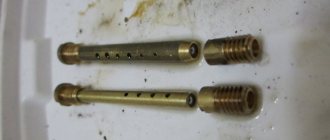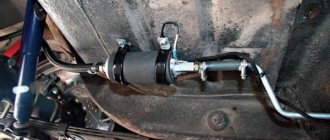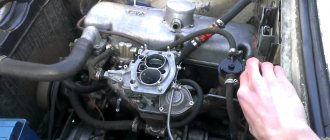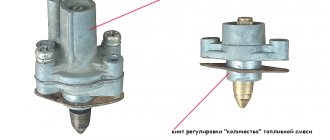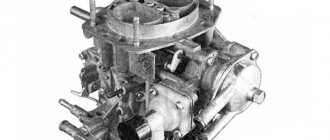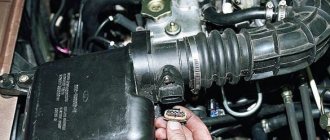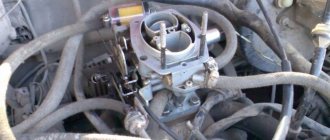Some owners of carburetor cars are accustomed to thinking of the carburetor as a rather simple device, although the carburetor is a group of systems that work in conjunction with each other. Failure of any component results in malfunctions in the carburetor, so these malfunctions should be corrected immediately. One of these components is the carburetor accelerator pump. Many car owners are not even aware of the existence of such a unit.
Acceleration pumps
In acceleration mode, when the throttle valve is opened sharply, a significant depletion of the combustible mixture occurs, which causes a “failure” in engine operation. This is explained by the fact that the density of air is significantly less than the density of gasoline, as a result of which, at the initial moment, the air flow through the air channel increases faster than the flow of fuel from the metering systems, which leads to an over-leaning of the combustible mixture. In addition, when the throttle valve is opened, the conditions for fuel evaporation worsen due to an increase in pressure in the intake manifold and a decrease in the temperature of the combustible mixture.
To prevent these negative phenomena, special devices are used in the carburetor - accelerator pumps, which supply additional fuel during sudden throttle openings.
The accelerator pump serves to improve engine response by forcibly injecting additional portions of fuel into the mixing chamber when the throttle valve is sharply opened. The accelerator pump, which can have a mechanical, pneumatic or diaphragm drive, is installed separately or combined with the carburetor economizer.
The most widespread are mechanically driven piston or diaphragm pumps. Figure 1 shows a diagram of a piston-type accelerator pump.
When the throttle valve 1 is sharply opened, the pump piston 6 moves down through the lever system and spring 5. When the piston moves, check valve 7 closes, and discharge valve 4 opens, and fuel is supplied through it to sprayer 2, from where it is injected into the carburetor air channel.
If the throttle valve opens slowly, fuel from the sub-piston space through the gaps between the piston 6 and its liner flows into the supra-piston cavity, and therefore the fuel supply by the pump is either reduced or stopped altogether. The pump is filled with fuel through check valve 7 when the throttle is closed.
Figure 2 shows a diagram of a diaphragm type accelerator pump. When the throttle valve 7 is sharply opened, the cam 6 located on its axis moves the lever 5 and, through the pusher 4, presses the membrane 3, overcoming the resistance of the return spring. The membrane, through the well of the accelerator pump, ball valve 2 and nozzles 1, supplies fuel to the mixing chambers of the carburetor, enriching the mixture. When the membrane returns to its original position, fuel from the float chamber is sucked through the check ball valve 8, entering the working cavity of the accelerator pump.
Before cars with computer-controlled engines, cars had carburetors. A carburetor is a device that supplies the fuel-air mixture to the cylinders in an internal combustion engine.
Operating principle
From the gas tank, the fuel mixture through the gas line first enters the cavity in the carburetor, and then goes to the fuel valve seat. When the engine is not running, the inlet hole on the seat is closed by a lever on the axle, which blocks the path into the cavity where the mixture pressure regulator is installed. Gasoline does not enter the combustion chamber.
At the beginning of the carburetor operation and when the unit is started, the rarefaction of the diffuser air through the rod pushes up the membrane in the pressure regulator device. At this time, the lever is pressed back, and the gas mixture passes through the seat into the cavity of the mixture pressure regulator. Then it enters the channels, the passage in which can be changed using adjusting screws, and is supplied to the nozzle device.
Atomized gasoline, enriched with air, is sucked into the diffuser during engine operation and enters the combustion chambers. To prevent air from passing through the cavity, a check valve is installed on the seat. This principle of operation improves the idle performance of the scooter engine.
The pressure regulator device consists of a membrane, a lever for closing the fuel channel and a steel spring, which is designed to maintain the same performance indicators of the device. In this case, the carburetor membrane is exposed to rarefied air on one side, and on the other, it is pressed by a spring.
As the air rarefaction increases and atmospheric pressure in the diffuser increases, sufficient force is applied to the membrane to move the lever and open the fuel supply valve. At this moment, the fuel supply increases, which compensates for the drop in pressure level in the cavity of the fuel mixture.
Solex carburetor design
The Solex carburetor has several models, namely:
The main modification of this brand of carburetors is SOLEX 21083. This model has the smallest diffuser cross-section. In terms of structure, all Solex models are the same, there are only some differences (different brands and models of cars have their own modification). Therefore, the Solex settings for all models are the same.
The Solex carburetor type is emulsion. It is installed only on cars with engines with contactless ignition.
Solex device:
- two chambers with throttle valves;
- chamber dosing system;
- transition systems for both chambers;
- idle speed system only for the first chamber.
Classification of Solex carburetors by configuration:
- Semi-automatic starting system.
- Carburetor accelerator pump.
- Power mode economizer.
Have you heard about a car device that can reduce fuel consumption, the FuelFree fuel saver?
Quality screw removal method
With Solex carburetors, the XX channel in the body itself often becomes clogged, and in order to clear it thoroughly, it is necessary to remove the quality screw. But this screw, as mentioned above, has a very tight fit and is not easy to get out. There are several methods for dismantling a part; we will consider only one option.
We take a piece of an old antenna from any radio receiver, select the outer diameter so that the tube fits into the channel of the carburetor body, usually the outer thickness of the “puller” is about 4 mm. We cut off a small piece, make a cut at one end (about 1 cm deep), use another quality screw (a spare one, or you can buy it specially in a store), and check how tightly the tube fits onto the head of the screw.
Now you can unscrew the screw and use a homemade puller to remove it from the KU body.
Adjusting carburetors is a delicate process and requires some caution. In order to obtain the desired result, the idle speed is usually adjusted. So, here is a standard carburetor for a VAZ 2109:
The “quantity” and “quality” screws with which the carburetor is calibrated are clearly visible here.
Fine adjustments are not made with the engine running. This is important - don't forget. What to do:
- Warm up the engine and turn it off.
- Take the mixture quality screw. First you need to tighten it to the limit. Then unscrew it four or five turns. As a result, we get a completely enriched mixture.
- Next, we do the same with the quantity screw, but unscrew it three turns.
- The preheated engine can now be started.
- Using the quantity screw you need to adjust the idle speed. The limit is 800 rpm.
- Now, slowly tighten the mixture quality screw. An important point is that the gas distribution mechanism, ignition and the carburetor itself must be in good working order!
- We adjust the speed further. They will grow a little at first. Then they will become less stable. As you continue to tighten the screw, they will become smaller. As soon as you notice that the speed is unstable, you can unscrew the screw half a turn.
- Next, we correct the speed using the quantity screw. Don't forget to check the number of revolutions under increased loads - with the oven on, for example. In winter, even from the usual 850 rpm, you should raise it to 1000.
How to set up a Solex carburetor
The best carburetor is SOLEKS. Therefore, many drivers replace their standard carburetors with devices of this type. Solex works clearly even if there was a strong overflow of fuel. As it turned out, many people have difficulties in correctly setting up the Solex carburetor. It must be configured so that fuel consumption is minimal and power is maximum, so you need to look for the “golden mean”. Therefore, those who do not want to learn the subtleties and nuances of setting up give this job to a professional.
When to change, what interior to install
To perform scheduled maintenance operations, there are regulations, as well as manufacturer recommendations. According to them, replacing the cabin filter of the Kia Rio II JB heating and air conditioning system should be done every 15,000 kilometers or once a year.
Considering that the operating conditions of the car in most cases will be far from ideal, experts advise performing this operation approximately twice as often, in spring and autumn.
Characteristic symptoms:
- Windows often fog up;
- the appearance of unpleasant odors in the cabin when the airflow is turned on;
- deterioration of the stove and air conditioner;
They may make you doubt that the filter element is coping with its tasks and an unscheduled replacement will be required. In principle, these symptoms should be relied upon when choosing the correct replacement interval.
Suitable sizes
When choosing a filter element, owners do not always use products recommended by the car manufacturer. Everyone has their own reasons for this, some say that the original is unreasonably expensive. Some people in the region sell only analogues, so there is a need to know the sizes by which you can subsequently make a selection:
- Height: 17 mm
- Width: 200 mm
- Length: 225 mm
As a rule, sometimes analogues for Kia Rio II JB can be a few millimeters larger or smaller than the original, there is nothing wrong with that. And if the difference is measured in centimeters, then of course it’s worth looking for another option.
Selecting an original cabin filter
The manufacturer recommends using exclusively original consumables, which, in general, is not surprising. They themselves are of good quality and are widely available in car dealerships, but their price may seem overpriced to many car owners.
Regardless of the configuration, on all second-generation Kia Rios (including the restyled version), the manufacturer recommends installing a cabin air filter with article number 97133-2E210 (971332E210) or its full analogue 97133-2E200 (971332E200).
It is worth noting that sometimes consumables and other spare parts may be supplied to dealerships under different part numbers. Which can sometimes confuse those who want to purchase an original product.
When choosing between a dust and carbon product, car owners are advised to use a carbon filter element. This filter is more expensive, but it cleans the air much better.
It is easy to distinguish - the paper filter accordion is impregnated with a carbon composition, and therefore has a dark gray color. The filter cleans the air flow from dust, fine dirt, germs, bacteria and enhances the protection of your lungs.
Which analogues to choose
In addition to simple cabin filters, there are also carbon filters that filter the air more effectively, but they are more expensive. The advantage of coal SF is that it does not allow foreign odors coming from the road (street) to penetrate into the car interior.
But this filter element also has a drawback - air does not pass through it well. GodWill and Corteco carbon filters are of fairly high quality and are a good replacement for the original.
However, in some retail outlets the price of the original second-generation Kia Rio cabin filter may be greatly inflated. In this case, it makes sense to purchase a non-original consumable item. In particular, cabin filters are considered quite popular:
Conventional dust cabin filters
- Mann Filter CU2336 – high-tech consumables from a well-known manufacturer
- BIG filter GB-9910 – popular brand, good fine cleaning
- Nevsky filter NF-6164 - Russian manufacturer with an affordable price
Carbon cabin filters
- TSN 9.7.115 – high-quality and thick carbon coating
- BIG filter GB9910/C – activated carbon
- Nevsky filter NF6164C – normal quality, affordable price
It makes sense to take a closer look at the products of other companies - they also specialize in the production of high-quality consumables for passenger cars:
- Corteco
- Filtron
- SCT
- Sakura
- GoodWill
- Fram
- JS Asakashi
- Champion
- Zekkert
- Masuma
- Nipparts
- Purflux
- Knecht Mahle
- RU54
It is quite possible that sellers may recommend replacing the Rio II JB cabin filter with non-original cheap substitutes with a much smaller thickness. They are not worth buying, since their filtering characteristics are unlikely to be at the proper level.
Solex carburetor tuning
Tuning, that is, improvement, modification of the carburetor is carried out to increase engine power and improve driving dynamics.
Important! In order to achieve maximum power, there must be a minimum of resistance at the carburetor inlet. With high resistance, the quality of the mixture is not always “at its best” (sometimes “poor”, sometimes “rich”).
If you sharply open the throttle valve with the Solex carburetor set at the factory, the air flow speed decreases, as a result of which less gasoline is supplied to the carburetor. Because of this, power drops significantly at low speeds.
The procedure for increasing engine power by tuning the Solex carburetor:
- We carefully disassemble the carburetor.
- We wash and blow, and divide into two halves.
- Pay attention to the air damper axis. There are protruding screws on this axis, which creates additional resistance while the car is moving. Any little things are important when tuning, so these protruding screws need to be smoothed out.
- Remove the axle and air damper from the top. The axle needs to be sharpened.
- From the lower part you need to pull out the throttle valves with their axles. At this stage, using a file we make the flaps larger. We hide the screw caps inside the axle. There are screws with conical heads, you can use them. The throttle valve needs to be assembled.
- Now we are tuning the diffusers. To improve the aerodynamics of the diffusers, it is necessary to make the legs in the shape of wings. We also check the protrusions of the factory casting; if there are any, they need to be ground off.
- The accelerator pump must have 2 tubes installed in one chamber. There is an opinion among some that when I use two tubes for each camera, “dips” may appear, that is, you press on the gas, but the car does not move.
In general, the basis of tuning is smoothing, erasing protrusions and irregularities. Any unevenness in the fuel and air mixing chamber creates resistance.
Idle speed adjustment
The most common problem with a Solex carburetor is the disappearance of normal idle speed; the engine begins to operate intermittently at low speeds. Very often, the cause of such a malfunction is either a clogged EMG jet or the solenoid valve itself. It is very easy to check this - while the engine is running at idle, we disconnect the wiring from the EMG; if the nature of the internal combustion engine does not change at all, and when the valve is unscrewed, the speed increases noticeably, then the defect is present.
You can try to restore normal operation of the XX without removing the entire assembly, and this procedure is quite simple:
- With the engine off, remove the air filter with housing:
- disconnect the EMG wire, unscrew the valve itself;
- we start the engine, plugging the “idle” channel with a finger, “accelerate” several times;
- we stop the engine, do not forget to blow out the EMG and its nozzle using a compressor or hand pump, separating these parts from each other;
- we put the parts in place, do a test start of the internal combustion engine: if the idle speed has stabilized, and when the wiring was removed, the speed changed, it means that the reason was precisely the blockage, and now the idle speed has “returned to normal.”
But it is not always possible to clean the channel in this way; specks may get stuck in the area of the quality screw. Here you already need to remove and disassemble the carburetor, dismantle the screw, which in general is not very difficult, since it is located deep in the channel and is held there by a rubber sealing ring.
Video
This video shows how to clean a Solex carburetor
This video is about tuning the small diffuser of a Solex carburetor
This is a general video on improving the SOLEX carburetor.
The VAZ accelerator pump is one of the important elements of the fuel supply system. The main function of this part is to supply fuel to the engine as soon as the carburetor throttle valves open. There are several types of problems associated with this part that all VAZ drivers should know about.
Adjusting the ignition angle
Sluggish acceleration of the car and instability of the idle speed are also often associated with incorrectly set ignition; this procedure is mainly carried out in car repair shops using special equipment. But if you wish, it’s easy to make the adjustment yourself, and without a strobe, and quite accurately:
- with the engine stopped, loosen the three nuts securing the distributor (the third fastening is located at the bottom, it is not visible from above);
- we start the car, turn the distributor-distributor clockwise (to “+”), and if the ignition was late, the idle speed will increase noticeably;
- we select the optimal position of the distributor (the operation of the internal combustion engine should be smooth, without failures), reduce the speed using the quantity screw, turn off the engine, fix the distributor-distributor with one nut for now, and check the results of the ignition adjustment on the fly.
If, under heavy load and sharp acceleration, your fingers begin to noticeably “knock” (engine detonation appears), you should move the distributor a little to “minus”, then check the car again while driving. This way you can set the ignition quite accurately, and sometimes even better than with a strobe light.
Checking the pump's functionality
To check, you will need to perform several preliminary steps:
- Pump fuel into the carburetor.
- Remove the air filter housing.
- Remove the carburetor cover so that you can see the operation of the mechanisms inside.
After this we perform a fairly simple test:
- Turn the throttle lever. At the same time, the pump mechanism should turn on. We look carefully at the system from above.
- Straight streams of gasoline should appear from the pump nozzle, which then enter the inlet well without problems. The streams should be continuous, even and strong for several seconds.
This is normal operation of the mechanism. If the accelerator pump malfunctions, you may observe the following defects:
- Weak oblique jets of fuel that do not even reach the intake well. The channels may be clogged, then it is necessary to clean the jets.
- If gasoline flows into the walls of the mixing chambers, you need to check the direction of the nozzles and correct it. Pliers will help here; you will have to use them to slightly bend the nozzles. This work must be done carefully, otherwise parts may break.
Alternative way
There is a simpler method for determining the correct position of the floats, which does not require measurements. Place the carburetor cover on a flat table and look at the stampings made on the side surfaces. When the floats are in a normally adjusted position, these strips are parallel to the lid.
Then we lift the floats up and look at their bottom, which after lifting should be parallel to the surface of the lid. If necessary, adjust the position of the floats by bending the tongue.
After adjustment work, we assemble the carburetor.
Cleaning the sprayer and pump channels
The VAZ accelerator pump consists of several parts that should be checked for damage or blockages. If the problem is in the fuel atomizer (nozzle), then you can generally limit yourself to cleaning, but in extreme cases you will need to replace it. To check, remove the sprayer using a slotted screwdriver. Next, just shake it. If no knocks are heard inside the device, it means there is a blockage.
The spouts of the part can be cleaned with compressed air, aerosol, or thin copper wire. The most extreme case is to soak the sprayer in acetone for an hour, before removing the rubber rings. After cleaning, we check the functionality of the system. If everything is still bad, buy new sprayers.
The VAZ-2109 carburetor pump often gets clogged, so it’s worth checking its channels for dirt.
It's easy to check:
- We remove the nozzles, fill the float chambers with fuel and turn the throttle until the accelerator pump is activated.
- Where there used to be a spray nozzle there should now be a trickle of fuel.
- As in the first case, it must be continuous, strong and direct.
If there is a weak gasoline supply, we clean the channels, and this is done like this:
- Pour a little acetone into the hole where the sprayer is connected. Then we clean the channel with a wooden stick or copper wire.
- Another option is to blow with air.
All fuel passages that lead to the accelerator pump need to be thoroughly cleaned. The problem may also be hidden in the diaphragm. If it is damaged, it needs to be replaced.
Method of folk Kulibins
Cooling system liquid pump repair
Vacuum carburetors often fail for this reason. To the question: what to do, people have long found an answer. In general, there are three solutions:
- The easiest, but also the most expensive, is to just buy a new carburetor and throw the old one in a box with garage trash, and go for a ride and enjoy the speed;
- Order and wait a long time for a part;
- Take special glue and simply seal holes or cracks in the membrane.
The third method is, of course, temporary, but with high-quality work and good materials, your membrane will last longer than the new ones from the repair kit. For gluing, we prepare a convenient place, glue, scissors and material for the patch.
We take the material for the patch. The Internet is replete with names of exotic materials. There are condoms, balloons, and surgical gloves. However, it is better to use an elastic, thinner membrane from another device. This patch will be more reliable. We cut it with scissors to the size of our part, coat it with glue.
What glue is best to use? People advise using any cyanoacrylic-based glue for gluing rubber products. We apply it to the damaged part and our patch, connect them, press and hold for a while. We leave our gluing until the glue is completely dry, assemble and install the carburetor on the scooter engine and ride with pleasure.
In conclusion, we note that all troubles with any mechanism can be solved on your own, saving time and money from the family budget.
Transitional system, GDS
When the driver presses the gas pedal, the throttle valve opens slightly. The engine receives fuel due to vacuum through the small diffuser of the first chamber and the jets of the main metering system. At the same time, the GDS is not yet fully operational, but the idle system is still working.
If you press the gas sharply, the accelerator pump will start. It injects a portion of gasoline through its spout directly into the manifold. The pump is designed to eliminate failures when starting and accelerating the car.
A further increase in speed entails an increase in vacuum. The force begins to retract the membrane, and it opens the draft of the secondary chamber. The diffuser and jets of the second chamber come into operation.
To prevent failures when the second chamber is fully opened, the DAAZ-2105 1107010 carburetor is equipped with a transition system. It is designed similarly to the idle system. But the hole for supplying the combustible mixture is located higher than the closed throttle of the second chamber.
Main types of jets and their selection
The industry produces 2 types of carburetor jets, which are included in each repair kit:
They are made for each camera of the device. The choice of jet depends on the cross-section of the large and small carburetor diffuser. Repair kits are produced differently - for each model and brand of car. The parts differ in hole diameter. How to adjust the correct operation of the engine - information necessary for every vehicle owner.
https://youtube.com/watch?v=9YsPr_IfCdo
Quite often, the Solex carburetor is installed on cars of other brands, with the most powerful engines. In this case, the machine will work intermittently, because the VAZ jets will not be able to do their job efficiently - due to the diameter being insufficient to supply the enriched mixture.
Often, car enthusiasts install a large fuel part for better acceleration and dynamic driving. In this case, one should not forget about the increase in fuel consumption. Also, increasing the diameter of the nozzle by several orders of magnitude will not always give a good result. The table can tell you how to choose jets.
If the engine capacity is 1.6 liters, you should not install a main jet from a powerful engine on it. If you are no longer satisfied with the acceleration of your car, you may need to look for another reason, for example:
- low compression level in one of the cylinders;
- the adjustment of the ignition system has gone wrong;
- one or more spark plugs are faulty;
- Replacement of high-voltage wires is required.
These are just some of the reasons and malfunctions, by eliminating which you will get a fast car again. Car enthusiasts have different opinions about altering jets, but most believe that it is not worth doing. Sometimes, those who like to save money install jets whose sizes are smaller than the recommended ones. In this case, you get an economical, but very weak car that will take a very long time to accelerate. Ozone carburetor jets should not be installed in a Ford carburetor. They should be on the classic Zhiguli.
Possible faults
Technical components of a system such as ozone carburetors for the 2105 model can fail at the most inopportune moment; in order to prevent breakdowns on the road, you should pay attention to the first signs of system operation. Main fault indicators:
Main fault indicators:
- Jerking of the car when revving up or releasing the accelerator pedal;
- Loss of speed when pressing the gas pedal sharply;
- Increased fuel consumption, unstable engine operation;
- Noticeable loss of power and acceleration speed.
The OZONE carburetor consists of many parts that can affect the operation of the car
It is necessary to take into account all signs and malfunctions in order to avoid major breakdowns. It is difficult to answer the question of which is better, OZONE or Solex carburetors, the latter has a simpler system of operation and adjustment, and has increased dynamic performance
A diagram of how to adjust fuel consumption, which is controlled by installing jets of smaller diameter.
Engines with the correct carburetor setting Ozone Lada 2107 are famous for their reliability, ease of operation, and maintainability. Adjustment and configuration for preventive purposes can be done with your own hands. If problems of a larger scale arise, you should contact a workshop where they will repair and tune the ozone carburetor, which will help avoid global problems in the future.
Possible faults
Technical components of a system such as ozone carburetors for model 2105 can fail at the most inopportune moment; in order to prevent breakdown on the road, you should pay attention to the first signs of system operation
Main fault indicators:
- Jerking of the car when revving up or releasing the accelerator pedal;
- Loss of speed when pressing the gas pedal sharply;
- Increased fuel consumption, unstable engine operation;
- Noticeable loss of power and acceleration speed.
The OZONE carburetor consists of many parts that can affect the operation of the car
It is necessary to take into account all signs and malfunctions in order to avoid major breakdowns. It is difficult to answer the question of which is better, OZONE or Solex carburetors, the latter has a simpler system of operation and adjustment, and has increased dynamic performance
A diagram of how to adjust fuel consumption, which is controlled by installing jets of smaller diameter.
Engines with the correct carburetor setting Ozone Lada 2107 are famous for their reliability, ease of operation, and maintainability. Adjustment and configuration for preventive purposes can be done with your own hands. If problems of a larger scale arise, you should contact a workshop where they will repair and tune the ozone carburetor, which will help avoid global problems in the future.
Dampers
Primary adjustment comes down to adjusting the cable on the trigger mechanism and adjusting the accelerator pedal traction. It is easy to adjust the thrust - the plastic tip is placed approximately opposite the hinge, twisting it along the thread. To secure, tighten the nut 10 mm.
The choke drive cable is adjusted as follows. The choke lever in the cabin is pushed in all the way, and the air damper must be fully open. The cable is threaded through the eyes, and the end is inserted into the corresponding hole in the clamp. While holding the latch, tighten the bolt with a wrench. When pulling and retracting the choke, you need to make sure that the damper opens and closes completely.
Next, check how the throttle of the second chamber opens. The membrane and rod must be in such a state that their stroke is sufficient to fully open the damper. If the stroke is not enough, then unscrew the nut that is on the rod and adjust the length.
